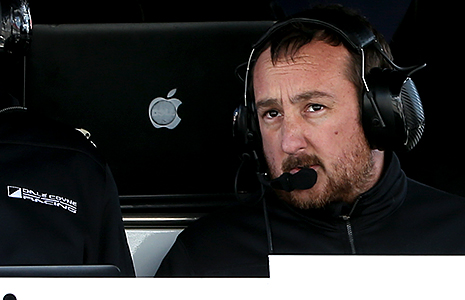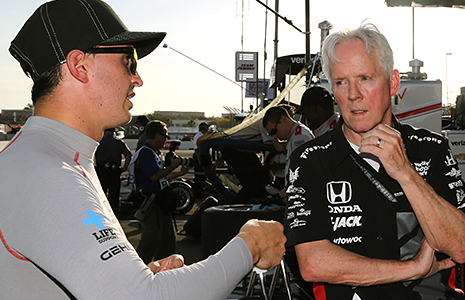They can’t wait. But for now, they’re confined to being watchful eyes.
As crews for Chip Ganassi Racing’s Scott Dixon and Schmidt Peterson Motorsports’ James Hinchcliffe tinkered during Thursday’s Honda manufacturer aero kit testing on the new Verizon IndyCar Series car, another group of engineers huddled nearby on pit road at Indianapolis Motor Speedway.
As jacket emblems showed, they were the competitors on other series race teams supplied by Honda. Just like on the racetrack, they’re never far away.
“We’re anxious. I think everybody is, right?” said Ray Gosselin, Andretti Autosport race engineer for 2012 series champion Ryan Hunter-Reay. “There’s a toy out there and other people can play and you can’t. We need our chance.”
He doesn’t expect his four-car team will get universal aero kit parts until after Thanksgiving, with a first test in early January. Until then, Gosselin is joined by other engineers in watching these tests to glean any information in addition to the data Honda shares with teams.
“Unfortunately, you’ve got two teams that are allowed to work on it and figure it out (now),” Gosselin said. “They’re not just doing things for Honda, they’re doing things for their own interest as well. Obviously, we have no idea what they’re doing, but the thing we’re looking for is how consistent is the car and anything you can pick up from just watching the test from afar. How often does it look like they are changing tires? Anything like that, anything that will give you some idea of what to expect when you finally get your hands on the thing and get a chance to go out.”
Dixon advised there were a lot of boxes that needed to be checked off.
“The electronics have changed on the car, the brakes, the aero kit, even cooling,” the four-time series champion said. “There’s a lot of things we just need to try and check off before they get into max production and start making things for the other teams.”
Andretti Autosport is alternating engineers for each test, the rationale being that different sets of eyes might notice different things.
 The competitor contingent of watchful eyes this day also included Olivier Boisson, Dale Coyne Racing engineer for Sebastien Bourdais, and Eddie Jones, race engineer for Rahal Letterman Lanigan Racing.
The competitor contingent of watchful eyes this day also included Olivier Boisson, Dale Coyne Racing engineer for Sebastien Bourdais, and Eddie Jones, race engineer for Rahal Letterman Lanigan Racing.
“The aero kit looks great,” Boisson (shown at right) said. “We’re just here to see what’s going on, just to make sure if there’s any issue we need to anticipate so we don’t get behind when we get our kit. But the car looks really good. From all the feedback I’ve heard, it looks very positive. We’re just excited to get ours and get to work with it.”
So far, he hasn’t witnessed any glitches.
“From what we’ve heard, it raced and handled pretty nicely,” Boisson said. “With the bodywork and not the bumper (rear wheel guards) anymore, it looks like there’s much less turbulence, so it’s going to be much better for the car behind and much cleaner air to race in.”
As much as drivers and fans have been initially enamored with the sleek look of the new cars, an engineer’s No. 1 priority is how the car performs. Setting up any car, especially a new one, can be tricky and takes time to learn all the subtle nuances.
 “We’re definitely eager,” said Jones (shown at right). “At the end of the day, the handling will dictate performance. I was at the Mid-Ohio test recently and certainly Hinchcliffe was happy with his car. I think the times are going to be competitive compared to 2017. Once we all get out there running and develop the cars, I think we’ll be just as quick as last year, if not quicker.”
“We’re definitely eager,” said Jones (shown at right). “At the end of the day, the handling will dictate performance. I was at the Mid-Ohio test recently and certainly Hinchcliffe was happy with his car. I think the times are going to be competitive compared to 2017. Once we all get out there running and develop the cars, I think we’ll be just as quick as last year, if not quicker.”
It’s a learning process with everyone basically starting from Square 1. And a key part of progress is how the engineers interact with their drivers.
“The big thing, beyond us actually being able to touch the parts, our drivers need a chance to feel it for themselves,” Gosselin said. “Just within our own team, we’ve got four different drivers. We don’t know much about Zach (Veach) yet, we’ll figure out what he likes, but just historically it’s hard to get four guys to agree on one setup. You might need to do things a little bit different for your driver compared to the guy sitting next to you. Until you actually get your guy in there telling you what he thinks it needs, it’s hard to get really get started on that.”
Engineers are just as curious as fans about how these cars will perform in traffic.
“From a fan perspective, how does it race?” Gosselin said. “If you’re a recent fan to INDYCAR, you’ve grown accustomed to what it has looked like around here since 2012. Is it still going to look that way or is it going to go back to where it’s a lot harder to pass?
“From a fan perspective, I think people are curious about that. From a team perspective, our big thing is how is it going to handle? What’s it going to take to be competitive in traffic around this place? There’s obviously different challenges at different tracks, but here (at IMS for the Indianapolis 500), that’s the big thing: How can you get the car to be able to pass and survive for 200 laps?”